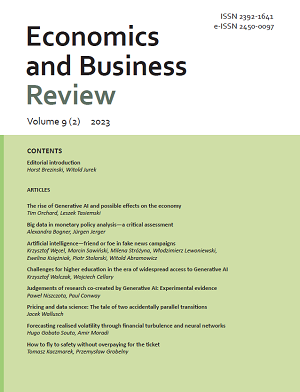Editorial Introduction
DOI:
https://doi.org/10.18559/ebr.2023.2.735Keywords:
big data, Artificial Intelligence, AIAbstract
Editorial
Downloads
References
Boulay du, B., Mitrovic, A., & Yacef, K. (2023). Handbook of artificial intelligence in education. Edward Elgar.
View in Google Scholar
Carayannis, E. G., Grigoroudis, E., Campbell, D. J., Sokratis, K., & Katsikas, S. K. (2023). The Elgar Companion to digital transformation, artificial intelligence and innovation in the economy, society and democracy. Edward Elgar.
View in Google Scholar
DOI: https://doi.org/10.4337/9781839109362
Malaney, P. (2023, April 24). Markets and artificial intelligence. Institute for New Economic Thinking.
View in Google Scholar
Marwala, T., & Hurwitz, E. (2017). Artificial intelligence and economic theory: Skynet in the market. Springer Nature.
View in Google Scholar
DOI: https://doi.org/10.1007/978-3-319-66104-9
Moloi, T., & Marwala, T. (2020). Artificial intelligence in economics and finance theories. Springer Nature.
View in Google Scholar
DOI: https://doi.org/10.1007/978-3-030-42962-1
Petersen, Th. (2020). Diginomics verstehen. UVK Verlag.
View in Google Scholar
DOI: https://doi.org/10.36198/9783838553399
Shen, K., Tong, X., Wu, T., & Zhang, F. (2022, June 7). The next frontier for AI in China could add $600 billion to its economy. Report. Quantum Black AI by McKinsey.
View in Google Scholar
Published
Issue
Section
License
Copyright (c) 2023 Horst Brezinski, Witold Jurek

This work is licensed under a Creative Commons Attribution 4.0 International License.






